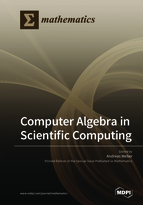Computer Algebra in Scientific Computing
A special issue of Mathematics (ISSN 2227-7390).
Deadline for manuscript submissions: closed (31 January 2019) | Viewed by 24189
Special Issue Editor
Interests: computer animation; physics-based modelling; computer algebra; life science informatics; hybrid modelling
Special Issues, Collections and Topics in MDPI journals
Special Issue Information
Dear Colleagues,
Although scientific computing is very often associated with numeric computations, the use of computer algebra methods in scientific computing has obtained considerable attention in the last two decades. Computer algebra methods are especially suitable for parametric analysis of the key properties of systems arising in scientific computing. The in general expression-based computational answers provided by these methods are very appealing, as they directly relate properties to parameters and speed up testing and tuning of mathematical models through all their possible behaviours. Thus, it is no surprise that a conference series with the name, Computer Algebra in Scientific Computing, is now going into its 20th year. Moreover, the development of computer algebra methods for scientific computing is also widely covered in conferences like the International Symposium on Symbolic and Algebraic Computation (ISSAC) or Applications of Computer Algebra (ACA). The topics addressed in this Special Issue are in the spirit of these conference series and cover all the basic areas of scientific computing as they benefit from the application of computer algebra methods, especially in the following topics:
- algebraic and semi-algebraic computations;
- symbolic-numeric methods for differential, differential-algebraic and difference equations;
- homotopy, perturbation and series methods;
- tropical and polyhedral methods;
- complexity of algebraic algorithms;
- automated reasoning in algebra and geometry;
- applications of computer algebra in the natural sciences and engineering.
Prof. Dr. Andreas Weber
Guest Editor
Manuscript Submission Information
Manuscripts should be submitted online at www.mdpi.com by registering and logging in to this website. Once you are registered, click here to go to the submission form. Manuscripts can be submitted until the deadline. All submissions that pass pre-check are peer-reviewed. Accepted papers will be published continuously in the journal (as soon as accepted) and will be listed together on the special issue website. Research articles, review articles as well as short communications are invited. For planned papers, a title and short abstract (about 100 words) can be sent to the Editorial Office for announcement on this website.
Submitted manuscripts should not have been published previously, nor be under consideration for publication elsewhere (except conference proceedings papers). All manuscripts are thoroughly refereed through a single-blind peer-review process. A guide for authors and other relevant information for submission of manuscripts is available on the Instructions for Authors page. Mathematics is an international peer-reviewed open access semimonthly journal published by MDPI.
Please visit the Instructions for Authors page before submitting a manuscript. The Article Processing Charge (APC) for publication in this open access journal is 2600 CHF (Swiss Francs). Submitted papers should be well formatted and use good English. Authors may use MDPI's English editing service prior to publication or during author revisions.
Keywords
- Algebraic computations
- Semi-algebraic computations
- Methods using differential algebra
- Homotopy computations
- Tropical and polyhedral methods
- Complexity of algebraic algorithms






